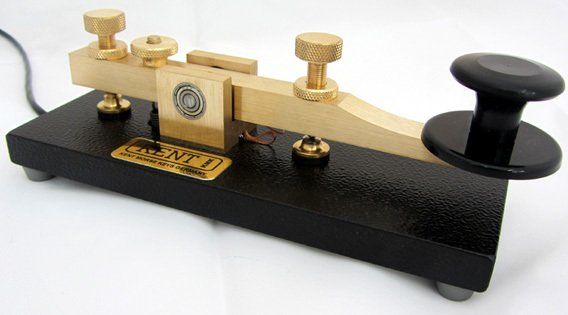Morse Code (CW)
Since passing my morse examination in 1986 I have continued to have a keen interest in sending and receiving code on the air. I can often be found calling CQ on the key, giving points away during CW contests or just exchanging details with other enthusiastic code operators. While volunteering at the National Radio Centre I enjoy allowing visitors to spend time sending CW on our practice keys.
I'm not a collector but I find myself owning three different CW keys, two straight and one iambic.
Ex-British Military Key WT8 Amp No2 Mk111-1
I purchased this key at a radio junk sale for just a few pounds, back in 1985. I practised sending with this key and used it to learn morse with. I was lucky to be able to take this key to my DTI morse exam and used it during the test to send CW.
The key has a simplified construction with the fixed contacts embedded in the Bakelite key base. The space contact (break) was at the rear and the mark (make) contact on the front. A separate lever of moulded Bakelite is held in place by a single pin.
Kent Brass Straight Key
A fellow amateur purchased one of these in kit form back in 1988. I was so impressed with the build and quality of the finished key I immediately went and purchased my own. It is built of solid brass on a hardwood plinth, and the only piece of plastic on this is the hand-grip. Two ball race bearings ensure a finely balanced movement and travel and tension adjustments are provided to enable the operator can adjust the key to their preference.
BEGALI SIMPLEX DUAL PADDLE MORSE KEY
During the Covid-19 lockdown I decided to treat myself to a new paddle key. The Simplex is a iambic key with a heavy (1.4 kg or more than 3 pounds) palladium plated base and gold plated components, using long springs for the return force. It is manufactured using NC machinery for absolute precision. Micro-threaded screws are used for all adjustments. The arms are held by 4 ball bearings that are embedded in the base, and they are made of a light-weight alloy that provides very low moving mass - this allows excellent responsiveness at high speeds even when set for a very light touch. The contacts are 925/000 silver
DigiMaster Pro 3 Digital Interface (G4ZLP)
For digital modes (FT8, RTTY, SSTV, PSK31) I use a DigiMaster Pro 3 digital data interface connected to my PC. The interface works with all data modes, AFSK and FSK are also supported. With a built in CAT interface it supports HRD, Logger32 and most CAT software. For those who want to send CW via software the Pro 3 features CW interface with WinKey emukation. The Pro 3 has a professional quality codec/soundcard IC and professional quality isolating transformers.



